#fossil coprolite
Explore tagged Tumblr posts
Photo

Ceratodus Fossil Coprolites – Upper Triassic – Aust Cliff, Westbury Formation, UK – Authentic Specimen
Ceratodus Coprolite Fossils in Matrix – Upper Triassic – Aust Cliff, Westbury Formation, Penarth Group, Bristol, UK
This listing features a genuine fossil coprolite specimen, attributed to the prehistoric lungfish Ceratodus, embedded in original matrix from the famous fish, reptile, and coprolite bed at Aust Cliff, near Bristol. This site is part of the Westbury Formation, a classic Upper Triassic locality in the UK known for its rich vertebrate fossil content.
Scientific & Geological Details:
Location: Aust Cliff, Bristol, England, UK
Formation: Westbury Formation
Group: Penarth Group
Age: Upper Triassic (~205–210 million years ago)
Depositional Environment: Lagoonal to marginal marine with periodic anoxic conditions—ideal for preservation of vertebrate remains and trace fossils
Fossil Zone: Part of the Rhaetian Stage, marking the transition to the Jurassic
Notable Species: Ceratodus was a genus of lungfish, a group that still survives today in limited forms. These fish were adapted to low-oxygen waters and left behind spiral or pellet-like faecal fossils.
Morphological Features of the Coprolite:
Typically cylindrical or spiral in form
Surface texture may show subtle spiral markings (if not abraded)
Matrix may contain associated microvertebrate remains including fish scales or bone fragments
Represents trace fossil evidence (not the animal itself but its biological activity)
Specimen Information:
Discovery Date: 07 April 2025
Collected By: UKGE team members Alister and Alison
Preparation: Expertly cleaned and stabilised by Alison
Scale Reference: Shown alongside a 1cm cube for exact sizing – see photographs for dimensions and angles
What You See Is What You Get: The photos show the exact item you will receive
Authenticity: Supplied with a Certificate of Authenticity. All our fossils are 100% genuine and responsibly sourced.
Educational and Collectible Value:
This coprolite offers a fascinating window into ancient biological processes and Triassic ecosystems. It's a perfect specimen for collectors, educators, students, and anyone interested in paleobiology or the evolution of vertebrate life. Trace fossils like this are invaluable for reconstructing diet and environmental conditions of ancient species.
#fossil coprolite#Ceratodus coprolite#Upper Triassic fossil#Aust Cliff fossil#Westbury Formation#Penarth Group#fish coprolite#lungfish fossil#ancient fish droppings#genuine fossil#prehistoric fish#UK fossil bed#coprolite specimen#fossilised faeces#vertebrate trace fossil
0 notes
Text
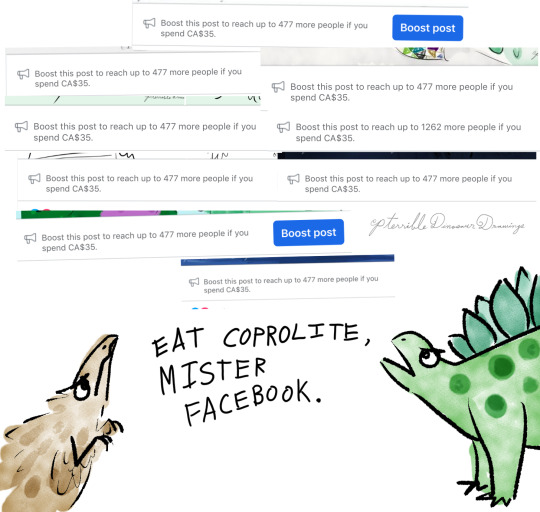
#facebook#(coprolite is fossilized poop)#also these numbers are pathetic! Even if I did want to pay for such a thing that's an awful deal!#tumblr blaze lets you annoy thousands more people for less than that
624 notes
·
View notes
Text

116 notes
·
View notes
Text


Phospraus [+Shiny]
I was talking about Fossil Pokemon like the day after the election and beyond just the interesting implications about them, what would happen if you tried to bring Coprolite to life? And while doing research for that, I came across the Lightening Stone, a strange piece of dinosaur dung that's likely been polished by sellers. So that's what he's based off.
#Phospraus#pokemon fanart#fakemon#art#fanart#artists on tumblr#nintendo fanart#pokemon#pkmn#pokémon#fossil#coprolite
16 notes
·
View notes
Text
Hey,,, life isn't too bad ,,, world's largest coprolite by a carnivorous animal <3

#shout out to the Poozeum™️#went with my family and told the guy I was studying to be a paleontologist and he gave me a free fossil#unfortunately it wasn't coprolite#but alas#I got a really funny t shirt form there too#paleontology#dinosaurs#dinosaur#coprolite
15 notes
·
View notes
Text
Calling it now.
Perucetus is going to be the mammalian Spinosaurus.
I bet as we find more fossils, Perucetus is going to get weirder from our (rightfully) conservative estimate. But it'll be in stages, and people will be tearing their hair out and bickering with each other while trying to figure just how on earth this thing functioned as a living organism.
#Palaeoblr#Paleoblr#Peruceutus#Spinosaurus#coprolite posting#Palaeontology#Paleontology#whale#dinosaur#fossils#Peru
104 notes
·
View notes
Text
Archaeology vs. Paleontology, how it feels to be elegantly told by Hawkman that you're dumb
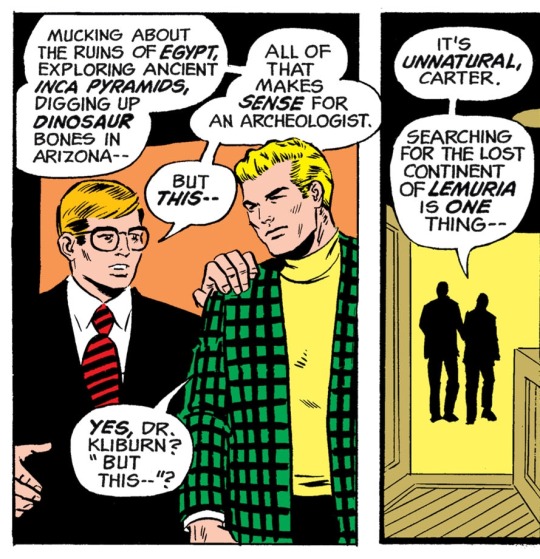
From All-Star Comics #61 & 62 (1976) by Gerry Conway, Keith Giffen & Wally Wood
I'm currently reading a JSA comic in which an astronaut flies to the surface of the sun and, instead of dying, becomes a powerful being capable of manipulating high levels of energy. I'm having fun, so I don't care about the science of it. However few pages later I get the panel above... Mixing up archaeology and paleontology? Now this is too much, that's where I draw the line! (Although I was too quick to judge, and Hawkman had my back all along).
I have no idea what is the scientific field of Dr. Kliburn's studies, but when he says: "Mucking about the ruins of Egypt, exploring ancient Inca pyramids, digging up dinosaur bones in Arizona -- all of that makes sense for an archaeologist" to Carter Hall a.k.a. Hawkman, an archaeologist, he badly mixes things up making dinosaur bones part of an archaeologist job. So ok, studying the remains of life is the business of many branches of science, and both archaeology and paleontology study the remains of organisms, but there's a difference in the type of remains they study.
Archaeology is the scientific study of ancient and recent human remains and artifacts (bones and teeth, ancient cool pottery, statues, funeral urns, tools, vases). Think: Lara Croft; Indiana Jones (I'm not saying he's good at his job though!).
Paleontology is the scientific study of all past life on Earth (dinosaurs, extinct fungi, plants, saber-tooth tigers etc), primarily through the study of fossils - so way beyond the remains of humans and their artifacts. Think: all the smart people in Jurassic Park; Ross, from Friends? (Oh boy we need better representation).
A little about objects of study: fossils studied by paleontologists and archeologists include bones, shells, body imprints, wood etc; so these fields of study might overlap (i.e. similar tools and excavation techniques), though their goals are different. Fossils can be remains of anything, there are different kinds of it. Trace fossils for example are like footprints, nests, or handprints left behind by creatures.
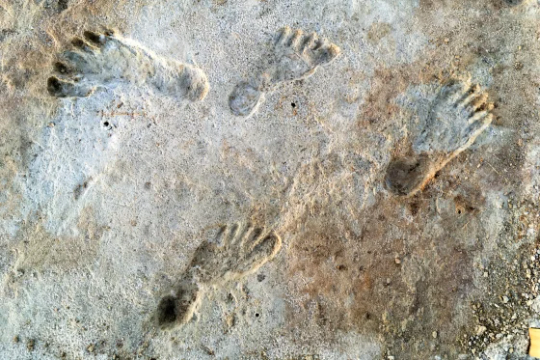

Above are the pictures of two cases of trace fossils, but while the study of the human footprints fossils on the left is a job for an archaeologist, the study of the non-human footprints, on the right, is a job for an paleontologist.
Now, what about poop? You might be asking yourself... and yes fossilized poop is also a fascinating object of study, they are scientifically called coprolites and by analyzing the fossilized poop of the Neolithic workers who built the the Stonehenge monument archaeologists found them littered with parasitic worm eggs. I mean... disgusting, but how cool is that we are able to learn that? They made these amazing structures which some people atribute to aliens and super advanced technology, but they had no idea they were eating infected meat, and that's such a human thing to do!
On the other hand when paleontologists study and collect animal fossil coprolites they find out more about that animal's way of life, their ecology, their environment, which is super important considering we can only study their remains. One of such early paleontologists, and true icon in the field of collecting ancient dinosaur feces and bones, was Mary Anning, a pioneer of paleontology in the early 1800s (she's cool as heck)!
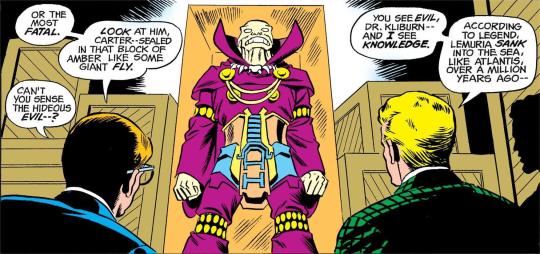
Now that we establish that: I'm sorry Dr. Kliburn, but that is obviously a human remain, therefore a job for Hall Carter, an archaeologist! He also mentions a fly trapped in amber (and I know it is a sort of metaphor, but), that would be a job for an paleontologist... Kliburn is a really confused man. And Hawkman is just too polite to bluntly correct his colleague, instead he chooses a more subtle approach:

By emphasizing that the "proper study of mankind is man" Carter very elegantly corrects Dr. Kliburn's wrong assertions, indirectly pointing that his field is the study of mankind and their artifacts, not other aspects of nature, he won't be looking into flies preserved in amber or excavating dinosaur bones in Arizona (although... to Kliburn's merit, Arizona is indeed a state with a rich fossil record with many different dinosaurs and other animal bones and trees preserved). A very polite way call someone a fool.
I'm guessing that the writer, Gerry Conway, was probably aware of the difference between the two occupations and interested in making a tongue in cheek comment on it. Not that comics need to be scientifically correct, far from it, I love it when they're not. But I also love it when we can use them to learn something.

Further indication of that point is that if we take a look at Hall Carter's home in the above panel, we don't see any signs of animal remains, we do see what look like human artifacts, tools, weapons and masks. It is clear Keith Giffen and Wally Wood, the artists of the issue, are aware of an archaeologist's objects of study. And if you're asking yourself who the uninvited guest is: yes it is Dr. Kliburn himself attempting to rob Hawkman's house...
Dr. Kliburn dies that same issue by the very human fossil he was trying to steal. So that's what you get for mixing up two serious and interesting scientific fields... Thank you for reading this!
#hawkman#justice society of america#comic book science#paleontology#archaeology#jsa#carter hall#all star comics#reading log#science#keith giffen#wally wood#gerry conway#dc comics#dc#comics#coprolites#fossils#text#comic panels#cw ross from friends#little essay
8 notes
·
View notes
Text


Coprolite (fossilized poop). 240 million years old, Middle Triassic, Moenkopi Formation.
2 notes
·
View notes
Text

coprolite- fossilized poop
4 notes
·
View notes
Text
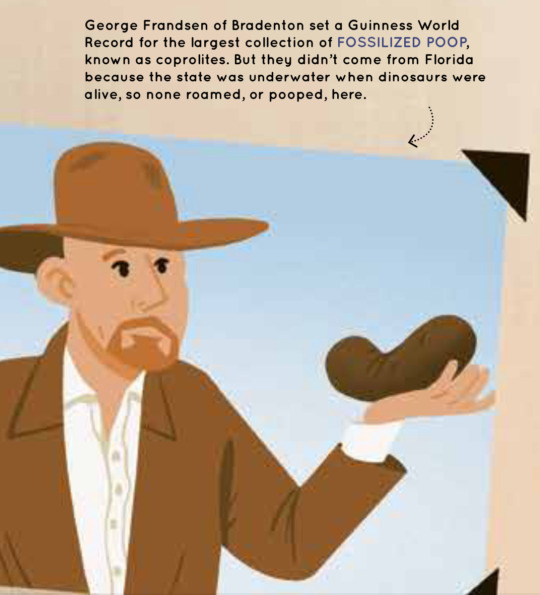
Only in Florida, written by Heather Alexander
#paleontology#coprolite#fossil#world record#florida#guinness world records#bradenton#facts#collection#collector
9 notes
·
View notes
Text
First molecular data on the human roundworm Ascaris lumbricoides species complex from the Bronze and Iron Age in Hallstatt, Austria
Published 25th July 2023
Study on Human feces conserved in salt, dating back to 1158-1063 BCE and 750-662 BCE, found in Hallstatt (a prehistoric salt mine) located in the Austrian. Microscopy and molecular methods are used to locate intestinal parasites and recovery of ancient DNA is performed, revealing first appearance of the roundworm Acaris Lumbricoides from the bronze and iron age.

Human Coprolites embedded in soil
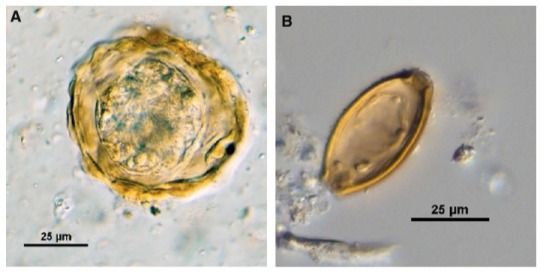
Ascaris egg from a sample from the Bronze Age, and Trichuris egg from a sample from the Iron Age with damage on the egg shell.

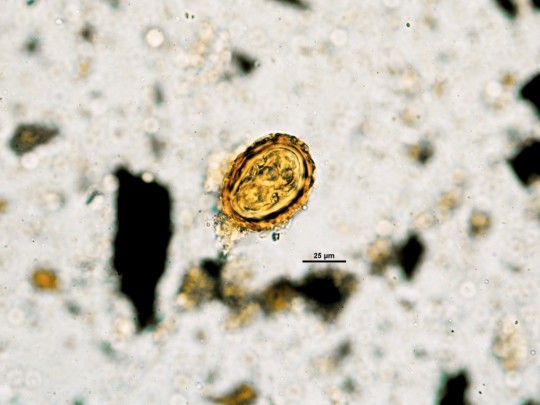
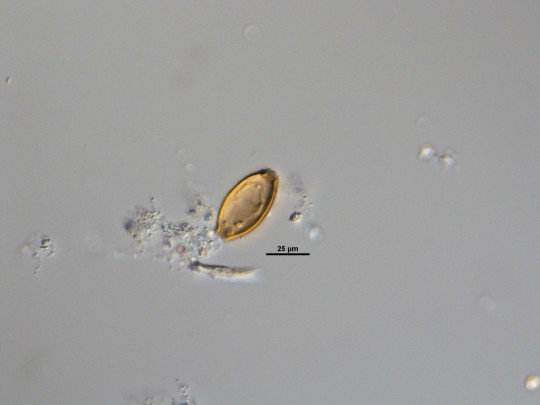

Acaris and Trichuris eggs
A morphological only analysis indicates that the eggs belong to Trichuris trichiura or Trichuris suis, and Ascaris lumbricoides or Ascaris suum.
DNA analysis revealed the Ascaris eggs belonged to Ascaris lumbricoides and the Trichuris eggs were not identifiable due to DNA degradation.
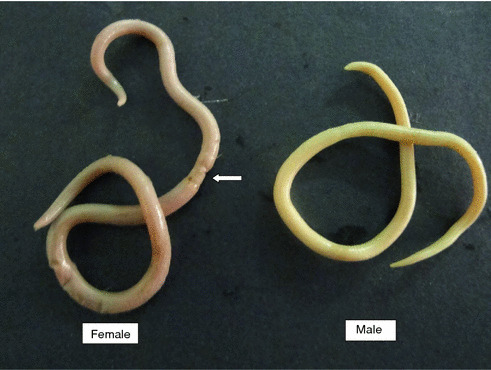
Ascaris lumbricoides, from

Trichuris trichiura, from (sorry for low quality image)

Trichuris suis, from
Source:
5 notes
·
View notes
Photo

Fossil Reptile Coprolite – Upper Triassic – Aust Cliff, Westbury Formation, Bristol UK
Fossil Reptile Coprolite in Matrix – Upper Triassic – Aust Cliff, Westbury Formation, Bristol, UK
This authentic specimen is a fossilised reptile coprolite, preserved in situ within a matrix from the iconic fish, reptile and coprolite bed at Aust Cliff, Bristol. The bed belongs to the Westbury Formation, part of the Penarth Group, and dates back to the Upper Triassic period, approximately 205–210 million years ago.
Scientific and Geological Context:
Location: Aust Cliff, Bristol, UK
Formation: Westbury Formation
Group: Penarth Group
Geological Period: Upper Triassic
Depositional Environment: Anoxic, low-energy estuarine/coastal lagoon – ideal for fossil preservation
Lithology: Laminated dark mudstones with concentrated fossil bone, tooth, and coprolite deposits
Palaeoecology: A rich snapshot of Upper Triassic coastal life, including reptiles, fishes, and their trace fossils
Fossil Significance & Morphology:
Coprolites are trace fossils that provide invaluable information about the diets and digestive processes of ancient organisms. This specimen is likely from a carnivorous reptile, evidenced by embedded bone or scale fragments.
Morphology Features:
Elongated, rounded coprolite with clear concentric growth or digestive textures
Possible inclusions of crushed bone or fish remains visible
Notable Value: Such coprolites are used in scientific studies to reconstruct Triassic food webs, and specimens from Aust Cliff are among the best-preserved from the UK
Specimen Details:
Discovered by: Our own field team – Alister and Alison – on 07 April 2025
Cleaned, prepped and treated by: Alison
Scale Reference: 1cm cube shown in photo; see image gallery for full size and detail
Authenticity Guaranteed: Comes with our Certificate of Authenticity – all our fossils are 100% genuine
Actual Specimen: What you see is exactly what you’ll receive – no substitutes
Ideal For:
Collectors of trace fossils, educators, palaeontology enthusiasts, and those interested in the dietary history of reptiles in the Late Triassic ecosystems. A fascinating and tangible link to prehistoric life, ideal for display or educational use.
#fossil coprolite#reptile coprolite#Triassic coprolite#Aust Cliff fossil#Upper Triassic fossil#Westbury Formation#Penarth Group#vertebrate coprolite#authentic fossil#UK fossil bed#prehistoric poo#fossil faeces#palaeo diet#collector coprolite#genuine fossil specimen
0 notes
Text
Over oude Schotse shit

Strandvakantie in Edinburgh
Begin deze maand vertoefde ik tot mijn verbazing in een zonovergoten Edinburgh. Niet het feit dat ik in de Schotse hoofdstad verbleef, verbaasde mij, dat was tenslotte ruim van tevoren gepland, maar dat het er suptropisch warm was, daar had ik niet op gerekend; dat bedenk je niet. 27 graden!
Gelukkig had ik voor vertrek, de baduitrusting staat standaard op de checklist, een zwembroek en een lichtgewicht badhanddoek tussen mijn poncho, regenbroek en zuidwester gepropt. Die kwamen nu mooi van pas. Mijn strandvakantie kon beginnen! Ik hoefde ik alleen nog maar een strand te vinden.
Na ampel speurwerk, Edinburgh is op z’n zacht gezegd geen echte badplaats, vond ik met behulp van Google Maps ergens langs de kustlijn van de Firth of Forth iets dat op een strandje leek. In Wardie Bay, tussen de golfbreker van Newhaven en die van Granton Harbour leek een strook zand zichtbaar. Omdat het op loopafstand lag, besloot ik erheen te gaan.
Wardie Bay
Bij aankomst bleek het grootste deel van Wardie bay ontoegankelijk. Een stijle zeedijk belemmerde de opgang. Ruim een kilometer verder dan gehoopt, vond ik uiteindelijk bij etablissement Old Chain Pier, van de oorspronkelijke pier was overigens niets meer zichtbaar, een doorgang. Om bij de zee te komen was nog wel het nodige klim- en klauterwetk vereist. Maar dat deerde niet. Ik wilde het strand op. Eenmaal onder aan de zeewering viel alles wat tegen. Het strand was amper dertig centimeter breed en het water ijzig koud.
Omdat ik het door alle inspanningen bloedverziekend heet had, nam ik een snel een plons, brrr, en maakte rechtsomkeer.
Terug in het vakantieverblijf bekeek ik de kaart nog eens aandachtig en vond waar het mis was gegaan: Ik had voor het strand nog ruim een kilometer verder moeten lopen. Het strand was geconcentreerd rond de pier van Granton.
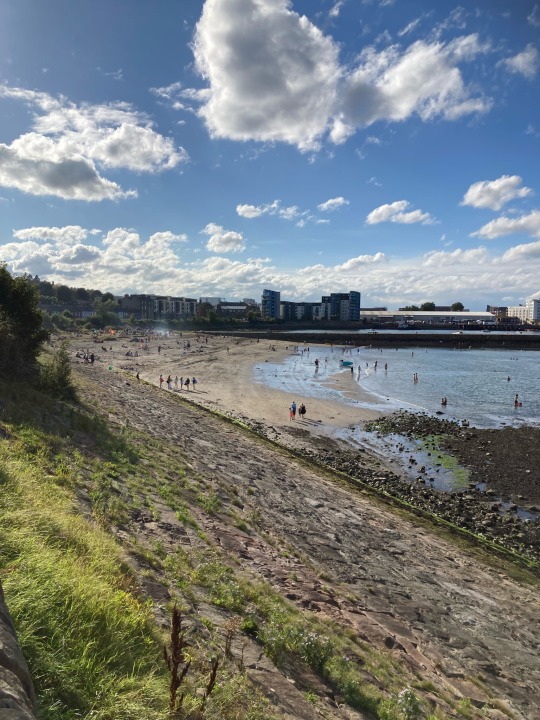
Een strand met historie
De volgende dag liep ik de opgang bij de Old Chain Pier voorbij en volgde de kustwal richting Granton. Halverwege trof ik een interessant informatiebord met de titel: Fossils, Feathers and Flowers. Volgens het bord was het door mij gezochte stukje strand een paleontologische vindplaats met een rijke historie. Grote namen uit de natuurhistorie bezochten Wardie bay om er te verzamelen. Louis Agassiz, Hugh Miller en Ramsey H. Traquair deden er geweldige vondsten. Veelal goed geconserveerde fossielen van beenvissen en haaien. Ook is er een amfibie gevonden. Veel van die vondsten liggen nu in het National Museums Collection Centre in Granton. Op een steenworp van de vindplaats dus.
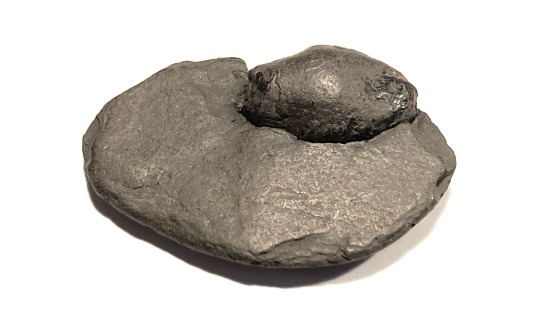
Een coproliet in matrix van een onbepaalde vis uit het Vroeg Carboon. In Wardie bay zijn dit de algemene fossielen.
Fossielen
Eenmaal op het strand kon ik het niet laten even in de voetsporen van Agassiz, Miller en Traquair te treden. Hoe vaak krijg je die kans. In een klein uurtje, ik had mazzel met het lage water, verzamelde ik een aantal fossielhoudende knollen. Precies zoals beschreven op het informatiebord. Helaas bevatten de knollen geen delen van een vissenskelet, dat zou wat zijn geweest, maar met de 340 miljoen jaar oude vissenpoep als inhoud ben ik al meer dan tevreden. Dergelijke vondsten maken een strandvakantie compleet.

Een voor Wardie beach typische Sideriet knol. Met daarin goed zichtbaar een coproliet. De coprolieten die in Wardie Bay gevonden worden kunnen van zoet en zoutwatervissen zijn. Gedurende het Vroeg Carboon moet er op de desbetreffende plek een zoetwatermeer zijn geweest dat zo nu en dan verbonden raakte met de zee, zodat marine fauna’s er toegang toe hadden.

De concentrische lagen, zoals goed zichtbaar in dit exemplaar zijn een typisch kenmerk van de vis coprolieten

Thuis heb ik een klomp doorgezaagd en gepolijst. Hierdoor werd het mogelijk de doorsnee van de coproliet te bestuderen. Onder de microscoop leverde dat interessante beelden op.
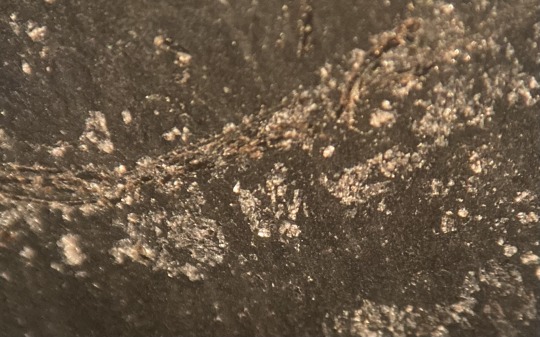
In de coproliet zijn duidelijke onverteerde resten zichtbaar. Wat dat durf ik niet met zekerheid te zeggen, maar het lijken wel graten.
Meer lezen
Fossil hunting around the city
Sharks that lived off edinburgh beach brought to life once again
Fossil fish coprolite discoveries on Wardie fossil hunt
Bringing the ancient sharks of Wardie bay back to life
Stan wood and challenging edinburgh fossil site
Granton and Wardie Shore, Edinburgh excursion
Fossil fishes of Great-Britain
#edinburgh#fossiel#fossil#beach#Wardie#Granton#Coproliet#coprolite#carboon#carboniferous#beach fossils#fish#shark
2 notes
·
View notes
Text
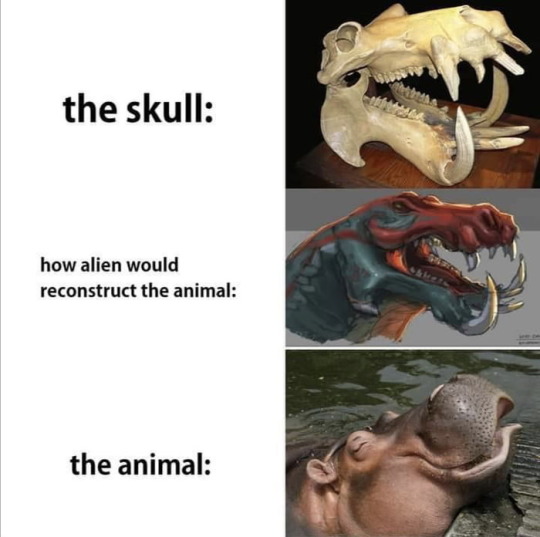
#memes#tumblr memes#meme#paleontology memes#coprolite posting#dank memes#animalblr#history memes#history meme#animal memes#animal meme#animal humor#hippo#hippopotamus#fossils
147 notes
·
View notes
Text

National Geographic, date unknown
I think whoever wrote this article had fun with the title.
#national geographic#coprolite posting#paleontology#fossils#beetles#3d scanning#feces#magazine article#magazine clippings#my scans
0 notes
Text
"I’ve said this before, but whether or not you consider yourself a dinosaur fanatic, everyone has an inherent love for dinosaurs. But, and I know I’m not the only one guilty of this, despite being fascinated by these long-extinct beasts, I never bothered to look into who uncovered their fossils in the first place. In comes Mary Anning, the woman who discovered the ichthyosaur, plesiosaur and pterosaur!"
Read the full article here:
#Mary anning#fossil hunting#history#women in history#the more you know#paleontology#reptiles#ammonite#coprolite#substack
1 note
·
View note